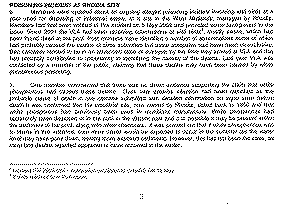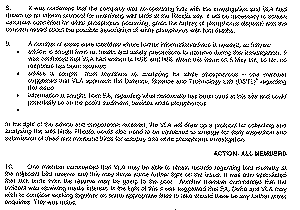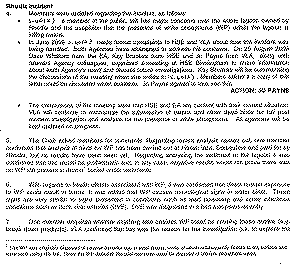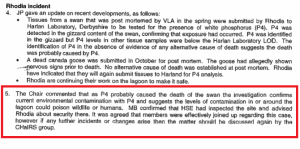After we informed the VLA about white phosphorus toxicity in the Rattlechain Sediment and after consulting the US expert staff who had worked at Eagle River Flats, the VLA referred this matter to the liason group CHaIRS, – Chemical Hazard Identification and Risk Surveillance Group.
The terms of reference of this group and membership list CAN BE READ HERE
“Terms of Reference – Revised March 2010:
To provide a forum for government organisations to share information in relation to chemical contamination incidents with the objective of improving communication and facilitating risk management”
The following are minutes taken from CHaIRS meetings which discussed the Rattlechain bird deaths, and referred to them as “the Rhodia incident”. These were obtained under The Freedom of Information Act after great difficulty following an internal review from the lead member of the group The Food Standards Agency. Read this review here
They reveal a shocking lack of knowledge and amateurism from these “professional agencies” in detecting the chemical poisoning cause of deaths of wildfowl on the site, and once again seem to be an attempt by the authorities to offer any half plausible explanation possible without considering the real prospect of white phosphorus poisoning offered by “a member of the public”, namely myself. The reality of these points is shown in black after each numbered point.
“POISONING INCIDENT AT RHODIA SITE
6. Members were updated about an ongoing alleged poisoning incident involving wild birds at a pool used for disposing of industrial waste, at a site in the West Midlands, managed by Rhodia.
Members had first been notified of this incident on 5 May 2009 and provided some background to the issue. Since 2001 the VLA had been receiving submissions of wild birds, mostly swans, which had been found dead at the pool. Post mortems have identified a number of abnormalities some of which had probably caused the deaths of birds submitted but some autopsies had been inconclusive.
Bird carcases tended to be in an advanced state of autolysis by the time they arrived at VLA and this had probably contributed to uncertainty in identifying the causes of the deaths. Last year VLA was contacted by a member of the public, claiming that these deaths may have been caused by white phosphorous poisoning.”
- I am the member of the public claiming that these deaths were caused by white phosphorus poisoning, based on the clinical signs being shown and the known link to white phosphorus being present in the sediment.
- Post mortems would be unlikely to have ever been able to identify the abnormal poisoning of toxic white phosphorus- as the VLA are unable to test for it, and knew nothing about the possibility of this chemical being a possible cause of death in 2001.
“7. One member commented that there was no direct evidence supporting the claim that white phosphorous had caused these deaths. Duck viral enteritis infection had been identified as the probable cause of death in one carcase submitted with detailed information on signs seen before death. It was confirmed that the industrial site, now owned by Rhodia, dated back to 1850 and that white phosporous (sic) had previously been used in munitions manufacture. White phosphorus had apparently been disposed of in the pool in the distant past and it is possible it may be present within the sediment of the pool, along with other chemicals. It was pointed out that if white phosphorous was to blame in this instance, then more cases would be expected to occur in the summer (as the water level may have gone down, leaving more exposed sediment). However, this has not been the case, as most bird deaths reported appeared to have occurred in the winter.”
- “No direct evidence” is the phrase which Rhodia used repeatedly in trying to deny the link between their toxic waste dumping and the bird deaths. They were wrong and so is the unnamed non “expert” who sits on this committee.
- The “detailed” signs were my observations, and these support white phosphorus poisoning, not duck viral enteritis.
- The ownership and dumping of toxic white phosphorus on this site by Albright and Wilson dates to pre 1948, not 1850. This is NOT “the distant past” and this is an attempt to try to muddy the waters of the truth about the disposal of this toxic chemical by a company who can be directly blamed for the deaths of these birds.
- The majority of Swans are unable to fly in the summer months when they are in moult. Rhodia can control the water levels in the lagoon, and have not turned on the pump as frequently in recent years, also building up the level of the causeway path, the effect of which has increased the water levels. Given that no fresh material has been dumped and the waste is below the water, the number of deaths should have decreased. The fact that they have not suggests that water levels themselves have nothing to do with this problem, but the stirring up of sediment certainly has.
- Whoever supplied this information to the CHaIRS group is clearly trying to rebuff my claims to their peers, whilst clearly supporting Rhodias. It is now only they who look like fools and one has to question the professional integrity of this individual and to what relationship they have to Rhodia
“8. It was confirmed that the company was co-operating fully with the investigation and VLA had drawn up an interim protocol for examining wild birds at the Rhodia site. It will be necessary to screen carcases submitted for white phosphorus poisoning, given the history of phosphorus disposal and the concern raised about the possible association of white phosphorus with bird deaths.”
- The company is co-operating only because they know that if they did not it would be a bad PR move. They did not co-operate with the VLA in 2001 by identifying toxic white phosphorus as being a potential cause of death.
- As already revealed- according to a letter from Ian Davies of the VLA dated 13th August 2009,
“Health and safety aspects have been adopted to minimise any potential exposure to white phosphorus when carrying out post-mortem examination of a carcase. These have included carrying out examinations in a safety cabinet, wearing appropriate protective clothing and placing gizzard unopened into a container for future potential laboratory analysis.”
He also adds “I have not been able to contact all staff from the VLA involved with investigation of mortality of birds at Rattlechain pool, but to the best of my knowledge, VLA were not aware of the presence of white phosphorus until advised by yourself.”
This confirms that Rhodia did not co-operate by informing the VLA that they could be handling hazardous toxic material and that VLA staff were doing so on the majority of post mortems which have taken place.
“9. A number of areas were identified where further information/advice is needed, as follows:
• advice is sought from re: health and safety precautions to observe during this investigation. It was confirmed that VLA had written to HSE and HSL about this issue on 5 May but, so far, no response has been received.
• advice is sought from members re: analysing for white phosphorous — one member suggested that VIA approach the Defence, Science and Technology Lab (DSTL) regarding this issue.
• information is sought, from EA, regarding what historically has been used at this site and could potentially be on the pool’s sediment, besides white phosphorous.
In the light of the advice and cooperation received, the VLA will draw up a protocol for collecting and analysing the wild birds. Rhodia would also need to be contacted to arrange for daily inspection and submission of dead and moribund birds for autopsy and white phosphorus investigation.
ACTION; ALL MEMBERS”
- Why are these people concerned with widening the scope of the chemicals in the sediment when they have not even tested it for white phosphorus? – Another attempt to muddy the waters of an investigation into the obvious toxic cause of death?
“10. One member commented that VLA may be able to obtain records regarding bird mortality at the adjacent bird reserve and this may throw some further light on the issue. It was also speculated that sick birds from the reserve may be going to the pool. Another member commented that the incident was receiving media interest. In the light of this it was suggested that EA, Defra and VLA may wish to consider working together on some appropriate lines to take should there be any further press enquiries. This was noted.”
- Once again an unnamed member attempts to muddy the waters by trying to introduce Sheepwash Nature Reserve into the equation instead of concentrating on the toxic white phosphorus sediment of Rattlechain Mere. If sick or dead birds are present on Sheepwash it is more likely that they came to be here as a result of ingesting toxic white phosphorus from Rattlechain Mere. THERE IS NO EVIDENCE OF ABNORMAL WILDFOWL MORTALITY AT SHEEPWASH NATURE RESERVE- UNLIKE THAT ON RATTLECHAIN MERE.
- “Let’s all get our story straight” is what the last point is suggesting. How can we protect the interests of Rhodia and our own useless organisations inability to diagnose toxic white phosphorus as the cause of death and in the case of the EA, being responsible for causing these deaths by telling the company to “rake the sediment” or redistribute it in the early part of this decade when they were still dumping waste and using sludge gulpers to redistribute the sediment.
- The same Environment Agency refuse to test the sediment for white phosphorus, but felt “expert” enough to try to blame the deaths on natural causes, or just about anything else but the toxic chemical which they allowed to be disposed of into here. Rhodia can control the lagoon levels like they can manipulate the evidence.
“Rhodia Incident
4. Members were updated regarding this incident, as follows:
• ******** a member of the public, still has major concerns over the waste lagoon owned by Rhodia and the suspicion that the presence of white phosphorus (WP) within the lagoon is killing swans.
• In June 2009 ******** made formal complaints to HSE and VLA about how the incident was being handled. Both Agencies have attempted to address his concerns. On 25 August 2009 Dave Whitford from the EA, Kay Brookes from HSE and J0 Payne from VLA, along with relevant Agency colleagues, organised a meeting at HSE Birmingham to share information about each Agency’s remit and discuss future investigations. Kay Brookes will be summarising the discussions of the meeting when she writes to ******* . Members asked if a copy of this letter could be circulated when available. J0 Payne agreed to look into this.
ACTION: JO PAYNE
• The conclusions of the meeting were that HSE and EA are content with their current situation.
VLA will continue to encourage the submission of swans and other dead birds for full post mortem investigation and analysis for the presence of white phosphorus. All agencies will be kept updated on progress.”
- My name is omitted under the data protection Act.
- At this point I had sent the VLA and the HSE Marianne Walshes comments about the video of dying swans on Rattlechain, yet they do not even mention this, or anything about Eagle River Flats studies.
- A private meeting takes place to once again “get the story straight” so that I can be fobbed off.
“5. The Chair asked members for comments. Regarding recent analysis carried out, one member confirmed that analysis of birds for WP has been carried out at Harlan labs, Derbyshire and paid for by Rhodia, but no results have been seen yet. Regarding analysing the sediment in the lagoon it was confirmed that this would be problematic and, in any case, negative results would not prove there was no WP still present in drums (1) buried under sediments. (1) The WP was originally disposed of several decades ago in steel drums, some of which subsequently floated to the surface and were sunk using rifle lire. Since the WP disposal, the pool has been used for disposal of calcium phosphate waste.”
- This officially confirms the negligent way in which Mike Peters and Albright and Wilson dealt with toxic barrels of chemical waste. “Problematic” means expensive. Why are the members of this group constantly trying to reduce the financial burden upon Rhodia?
- Do “Negative” or “small amounts” of WP found in birds therefore not prove that the birds have not ingested fatal amounts of this toxic substance
“6. With regards to health effects associated with WP, it was confirmed that direct human exposure to WP could result in burns. It was added that WP causes neurological signs in water birds. These signs are very similar to signs presented in conditions such as lead poisoning and some infectious conditions such as duck viral enteritis (DVE). DVE was diagnosed in a bird autopsied recently.”
- The neurological signs of white phosphorus poisoning in waterfowl are not at all similar to chronic lead poisoning of wildfowl. This is another attempt to broaden the spectrum of investigation and divert attention away from white phosphorus in isolation. DVE has not been diagnosed in the many birds showing neurological signs of white phosphorus poisoning.
“7. One member enquired whether anything else besides WP could be causing these deaths (e.g.break down products). VLA confirmed that this was the reason for the investigation (i.e. to explore the possible causes). The Chair added that it was appropriate for VLA to conduct comprehensive post mortems on the birds in each case and not just focus on WP.”
- Could anything else be causing these deaths?” – Is this the last desperate attempt by the Rhodia agent on this committee to try to prevent analysis of white phosphorus exposure, or just a naive comment from someone who does not know what they are talking about but pretends to?
- It is appropriate to conduct comprehensive post mortems on the birds in each case and focus on white phosphorus when clearly the VLA have been completely unable to identify a cause of death in most cases, and even in the cases where they have offered a cause, these birds have not been tested for white phosphorus, thus the link cannot be ruled out.
“8. On the question of future monitoring and analysis as part of the ongoing incident investigation, VLA confirmed that they would be working with Rhodia regarding this issue. They would particularly be looking for the site to be more regularly monitored in future (e.g. weekly) and would continue to investigate the cause of death of all dead birds submitted and monitor for WP.”
- I now monitor this site daily, is once a week really appropriate when this company own this site and clearly do not submit all dead birds reported to them by myself for post mortem or white phosphorus analysis, or delay the retrieval and submission of them, thus destroying the potential evidence.
“Rhodia incident
4. JP gave an update on recent developments, as follows:
• Tissues from a swan that was post mortemed by VLA in the spring were submitted by Rhodia to Harlan Laboratory, Derbyshire to be tested for the presence of white phosphorus (P4). P4 was detected in the gizzard content of the swan, confirming that exposure had occurred. P4 was identified in the gizzard but P4 levels in other tissue samples were below the Harlan Laboratory LOD. The identification of P4 in the absence of evidence of any alternative cause of death suggests the death was probably caused by P4,
• A dead canada goose was submitted in October for post mortem. The goose had allegedly shown nervous signs prior to death. No alternative cause of death was established at post mortem. Rhodia have indicated that they will again submit tissues to Harlan for P4 analysis.
• Rhodia are continuing their work on the lagoon to make it safe.”
- They were told but didn’t listen. This is the report referred to. 0071-0783
- So Rhodia’s lagoon is “unsafe”- what a pity they did not share this information with the relevant authorities when they tried to say the lagoon contained only “harmless” calcium phosphate.
“5. The Chair commented that as P4 probably caused the death of the swan the investigation confirms current environmental contamination with P4 and suggests the levels of contamination in or around the lagoon could poison wildlife or humans. MB confirmed that HSE had inspected the site and advised Rhodia about security there. It was agreed that members were effectively joined up regarding this case, however if any further incidents or changes arise then the matter should he discussed again by the CHaIRS group.”
On this point, Rosemary Cairns of the FSA who reviewed my request for withheld information made the comment
“17. In relation to the statement in paragraphs of the December 2009 minutes: “The Chair commented that as P4 probably caused the death of the swan the investigation confirms current environmental contamination in or around the lagoon could poison wildlife or humans.”
the CHaIRS group has asked that I clarify that this comment only applies to wildlife or persons coming into direct contact with sediments in and immediately around the lagoon by swimming, wading or interfering with sediments or soil in or immediately around the lagoon, where P4 may have been disposed of or contaminated.”
- How reassuring to both myself, other swan watch rescuers and wildfowl that have come into direct contact with the sediment by these means described.
- This group appears to be little more than a talking shop for Government quangos, with virtually no information available on the DEFRA website for what it actually does to justify its existence. If they were interested in identifying the chemical hazard risks of this site then why do they and not Rhodia identify the obvious links to bird mortality on the pool?
- What surveillance have they ever undertaken at Rattlechain lagoon?
- A freedom of information request to the HSE confirms that NO INSPECTION OF THE SITE HAS TAKEN PLACE BY THEM, AND THAT THIS HAS BEEN MINUTED ERRONEOUSLY AS GIVING THE IMPRESSION THAT THEY HAD.
- THIS INCIDENT HIGHLIGHTS PROFESSIONAL VANITY WITHIN GOVERNMENT WHEN SO MANY INDIVIDUALS CAN PONTIFICATE AROUND A TABLE, YET GIVE NO CREDIT WHATSOVER TO THE AMATEUR WHO IDENTIFIED THE CHEMICAL HAZARD AND THE RISK,DID THE SURVEILLANCE AND EXPOSED THEIR INCOMPETENCE. CHaIRS- unfit for purpose. “STOOLS” would be more appropriate- Secrete Toxic Ordnance in Outside Lagoon Sediment.





